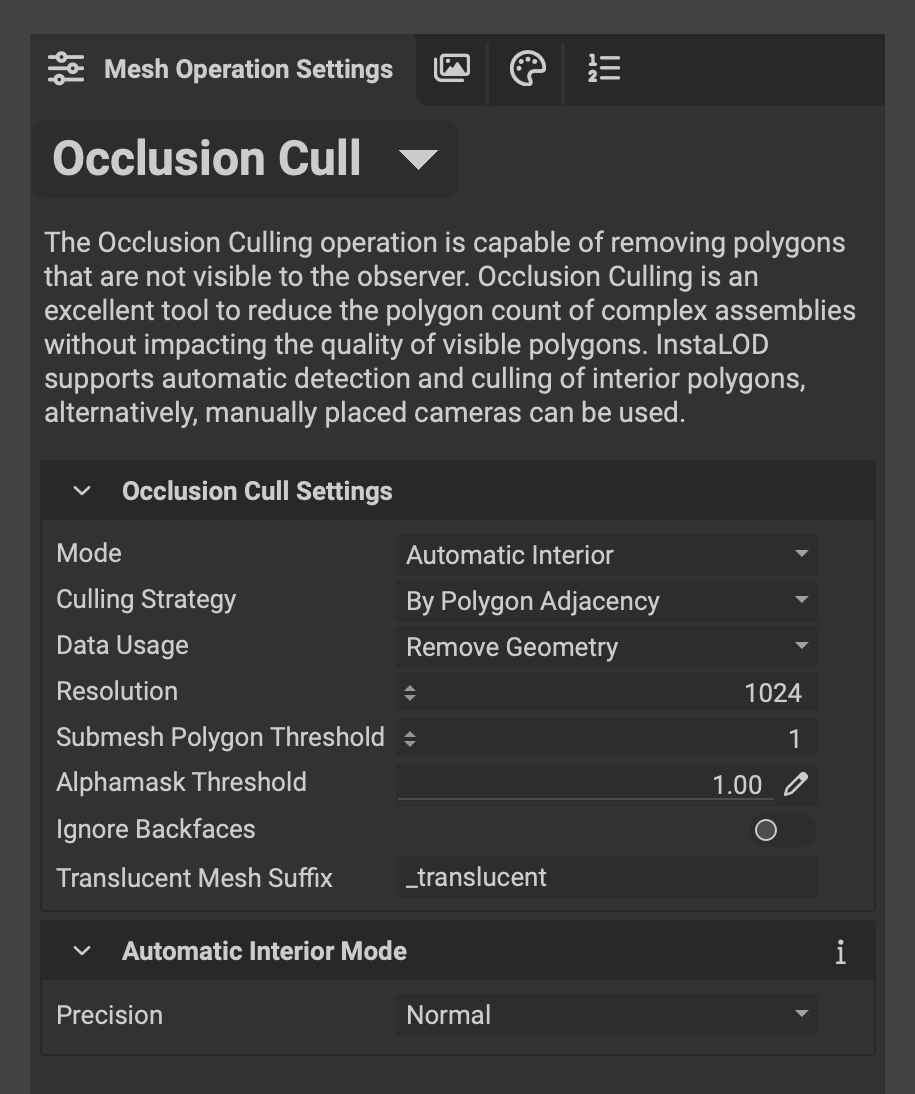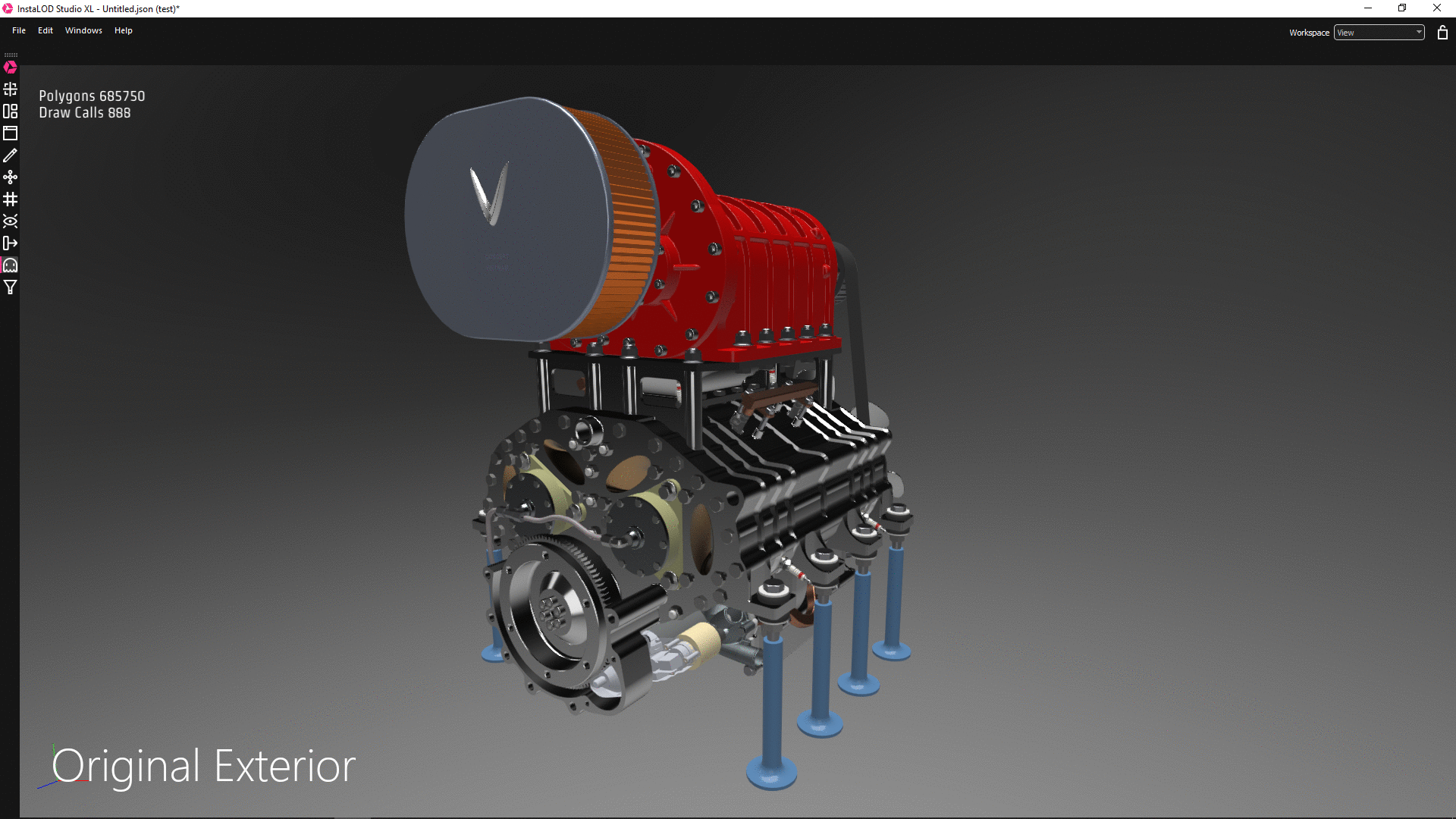Occlusion Culling describes the process of removing geometry from an object that is not visible. InstaLOD features two modes that allow for either interior polygon detection or a camera-based mode where cameras are used to determine if the geometry is within or outside of the setup camera's view.
¶ Settings
 The following is an overview of the mesh operation's settings:
The following is an overview of the mesh operation's settings:
- Culling Strategy: Determines what parts of an object to select - either complete objects, sub-meshes, or individual polygons. Using the
Data Usagethe user can specify what happens with the selected geometry. EitherRemove Geometry,Write Into Vertex ColorsorWrite As Optimizer Weights. - Resolution: Works comparable to a ray-tracer and looks to see which parts of the geometry is visible and which parts are not.
- Adjacency Depth: Protects neighboring faces when removing geometry.
- Submesh Face Threshold: Determines the visibility of a submesh. The submesh is marked visible if its visible face count is greater or equal to the specified value.
- Alpha Mask Threshold: Considers materials and textures with alpha values equal to or below to be transparent. For objects to be considered translucent the
Translucent Mesh Suffixcan be used. - Ignore Backfaces: When enabled, backfaces will not occlude geometry. When disabled, backfaces will occlude geometry.
- Translucent Mesh Suffix: Mesh names that match the
Translucent Mesh Suffixwill be marked translucent for the ray tracer. Translucent surfaces can also be set up when using textures with an alpha channel.
¶ Advanced
- Deterministic Execution: Makes the algorithm deterministic at the cost of speed.
¶ Occlusion Cull Modes
InstaLOD provides two modes to control the Occlusion Culling process.
¶ Automatic Interior Mode
The Automatic Interior Mode provides a one-click solution to remove occluded interior faces. Depending on the polygon density it can be necessary to increase Precision, Resolution and the Adjacency Depth to prevent the creation of holes.
The Precision determines how precise the object is examined. The higher the precision the more tests are performed to determine the visibility of the individual polygons.

¶ Camera Based Mode
The Camera Based Mode maintains polygons or objects within the camera view and removes anything outside of the view.
Using the Render Output Path, a snapshot can be saved of what is visible by the raytracing camera.
Use the Translucent Mesh Suffix to specify translucent meshes that should not occllude geometry during processing.

¶ Adjacency Depth
When dealing with high-poly objects and a low Resolution number, holes can occur due to the resolution not being high enough to pick up all of the tiny polygons in the mesh. Increasing the Resolution will increase performance cost, however utilizing an Adjacency Depth provides an added "saftey blanket" of connected polygons to prevent possible holes as a result of the operation.
Here is a table of examples when using the Adjacency Depth setting in conjunction with a lower Resolution number.
| Adjacency Depth | Result |
|---|---|
| 0 | All faces that are not visible during rasterization will be culled. |
| 1 | Direct neighbor of faces that are marked visible will also be marked visible. |
| 2+ | Neighbors of neighbors will also be marked visible. |
When not using a
Custom Texture Page Configurationtexture names that contain the stringalphamaskwill be used as an alpha mask. When using aCustom Texture Page Configurationtextures that act as alpha masks must be set up manually.